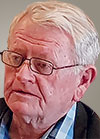
Two-way radios form a critical communication link between security personnel and control rooms, providing instantaneous feedback for real-time reaction. But, as Hi-Tech Security Solutions discovered, there’s more to this technology than just the ability to speak and listen.
Although Canadian inventor Donald Hings was generally believed to have invented the first mobile two-way radio in 1937, other sources claim that this honour should be accredited to Frederick William Downie, an Australian policeman who introduced sets to patrol cars in 1923. The radios, while novel, reportedly took up the entire back seat of the vehicles. The ‘walkie-talkie’ as it was commonly known, has come a long way and is now available in both analogue and digital formats.

Tony Lohrentz of Halo Technology says that in their early days, two-way radios used crystal technology with a push-to-talk (PTT) and release-to-listen button on one channel per radio set. “If you required a second channel, it was only available in 1 MHz increments. There were also very few features on these early radios.”
He says that the new digital-format radios have redefined mobile two-way radio-wave communication, allowing you to speak to another person anywhere in the world as long as you have cell phone coverage. “These radios have extensive features and we commonly customise their design and construction for each specific customer, allowing them to make phone calls, activate panic alarms, send messages and so forth.”

Mandla Booi of Altech Alcom Radio reiterates that current digital two-way radios are feature-rich tools that increase safety and enhance productivity. “Digital voice quality is greatly enhanced and with GPS-integrated technology, control rooms can now track radio users as well as other assets for efficient and effective deployment of the closest resources to an event. Other benefits are that text messaging on the radio allows job ticketing instead of the security officer physically having to collect work orders.”

Booi says that the radios can be used for time and attendance (T&A) due to the fact that when the security guard switches on his radio, he will be automatically registered as being on duty and when he switches off the radio, the radio will register him as being off duty.
Digital wins
Lohrentz believes that digital radios have changed the efficacy of security on residential estates due to their versatility. An example is the quality of speech patterns with respect to increasing distances between radio operators. Analogue radio speech quickly deteriorated with increasing distance but the digital versions allow the speech patterns to remain unaffected over far greater areas of separation.
In spite of these advantages, there are a number of people still using analogue radios, he points out. “This can, in most instances, be attributed to budgetary constraints. However, we now have software that allows us to convert analogue Motorola radios to digital technology at minimal cost.”

According to Ian Coleman of Scan RF Projects, whilst applications such as GPS tracking and telemetry were certainly possible over narrow band analogue radios, the evolution of digital radios provides one with access to medium-speed data transmission over IP-connected wide-area radio networks.
“The evolution into the digital realm means that we are now using the RF spectrum more efficiently. To general radio users it would seem that, from outward appearances, nothing has changed in the move from analogue to digital. However, it’s what is inside that is the differentiator. With digital radios, connection is instantaneous. Users can now also select whether they want to talk to just one person or include many people in the radio conversation,” says Coleman.
The case for residential estates
So, are two-way radios still commonly used on residential estates, or have they been relegated to a dusty cupboard in favour of cellular phones? Lohrentz says that radios still play a critical role on many estates and cites the recent 10-day power outage in certain areas of Pretoria as a perfect example of how radios can save the security day.
“At the prestigious Silver Lakes residential estate, the lack of power to perimeter fences and access control systems meant that the estate was a potential soft target for criminals. However, the security guards patrolling the estate used radios to allow them to quickly relay any information on possible issues to the control room.”

Booi concurs, saying that the benefit of their digital radio technology, with integral RFID capabilities, means that patrolling guards no longer need to physically make contact with a touchpoint. “By merely walking past the touchpoint, the RFID technology registers the action, thereby saving time for all. The radios can also be programmed to activate an alarm in the control room, should a guard miss a checkpoint on his route. In addition, the radios come equipped with a panic button that allows an alarm to be sent to control room in the event of emergencies.”
In terms of infrastructural requirements, it is agreed that repeaters strategically located on high points in larger estates, will provide extended communications coverage.
Depending on the system used, digital two-way radios can be integrated with other estate systems and security technologies such as CCTV cameras and security booms and gates, provided that these systems also use a digital network.
Booi adds that a control room is the number one requirement for allowing the integration of multiple solutions. “Should a surveillance camera pinpoint nefarious or suspicious activity on an estate, the controller can then communicate directly with the security guard closest to the event and dispatch the guard to investigate the matter.”
Bells and whistles
There is no doubt that the latest digital two-way radio technology has elevated the popular walkie-talkie to the realm of advanced security tool. With a plethora of features and functionality, estates are spoiled for choice.
Halo Technology’s top of the range offering has GPS Live Track, allowing the control room to track the operator’s radio and do voice recordings, as well as record all the messages sent and received on the radio to the server. These radios allow the parties to participate in either individual or group calls, activated by selecting an option on the radio’s scroll down menu.
The Halo radios are equipped with geofencing, which allows the estate to ring each radio user on a laptop, thereby limiting the guard to a specific area. When the guard leaves this pre-allocated zone, the radio will send an alarm to the control room and/or a manager’s laptop. Smart PTT on the system uploads a link that allows the operators to listen to any conversations transmitted via the radio from the guard or assailants and furthermore allows the controller to talk to the guard or whoever has the radio in their possession.
Booi says that the Motorola radios have a number of value-added features including Lone Worker, which forces the radio user to interact with their radio at preset time periods. If they do not interact, for example when they have fallen asleep, an alarm is sent to control room.
If a radio user falls down, then the Man Down feature is activated and an alarm is sent to the control room so the controller can check if the user has fallen by accident or if he has been attacked, thereby allowing for quick response to an incident.
The Remote Monitor function allows the control room dispatch operator to ‘open’ the microphone of the radio, providing them with the ability to listen in on the security guard’s conversations and interactions.
A high level of encryption on the radios means that all communications are secure and no unintended parties can listen in on private conversations.
Coleman highlights two dominant technologies used by Scan RF Projects in PTT radios, namely TETRA and DMR – the latter is available in Tier 3 larger trunked radio systems, and Tier 2 for smaller conventional deployed systems. Two channels in one means that data services, RFID tagging, proximity detection and man down features can happen in the background without any disruption of voice communication. These radios provide high levels of encryption, superior voice recording quality, high-end security of systems and higher data throughput. Integrated consoles are available to bring all security platforms into one command and control environment.
Conclusion
In spite of the increasing use of mobile cellular technology, the digital two-way radio is here to stay for the foreseeable future and, as technology continues to advance, these radios will continue to provide a fast and efficient way of communicating on any residential estate.
For more information, contact:
Altech Alcom Radio, [email protected], www.arh.net.za
Halo Technology, [email protected], www.halotechnology.co.za
Scan RF Projects, [email protected], www.scanrf.co.za
| Tel: | +27 11 543 5800 |
| Email: | [email protected] |
| www: | www.technews.co.za |
| Articles: | More information and articles about Technews Publishing |
© Technews Publishing (Pty) Ltd. | All Rights Reserved.